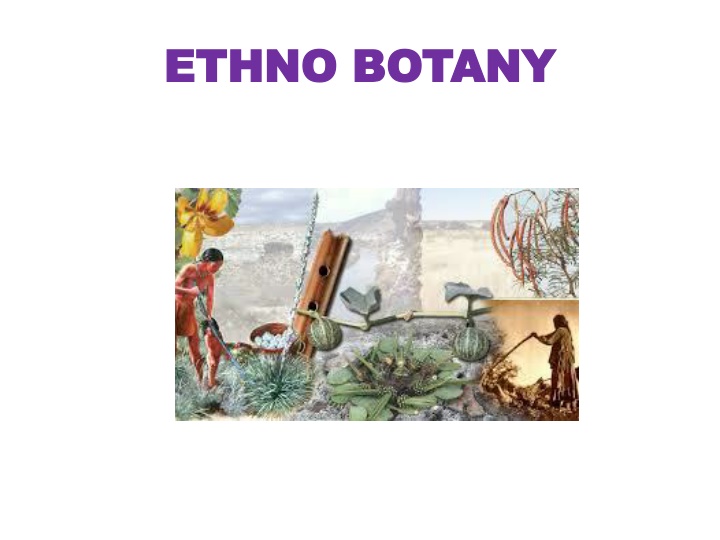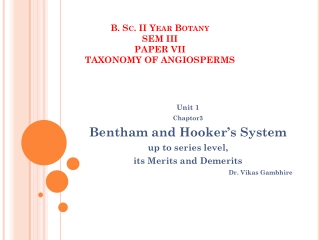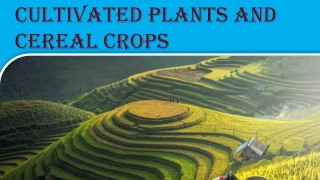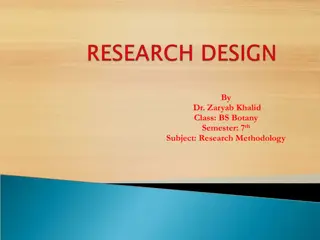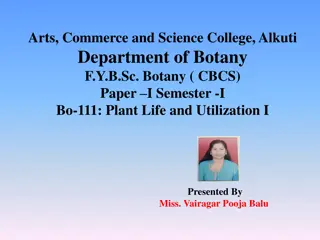Exploring the World of Ethno-Botany: A Comprehensive Overview
Ethno-botany, the study of plants used by primitive and tribal peoples, has evolved as an interdisciplinary science with relevance to various fields. From its origins in ancient societies to its modern-day importance in resource management and biodiversity conservation, ethno-botany plays a crucial role in understanding the interactions between humans and plants.
Download Presentation

Please find below an Image/Link to download the presentation.
The content on the website is provided AS IS for your information and personal use only. It may not be sold, licensed, or shared on other websites without obtaining consent from the author.If you encounter any issues during the download, it is possible that the publisher has removed the file from their server.
You are allowed to download the files provided on this website for personal or commercial use, subject to the condition that they are used lawfully. All files are the property of their respective owners.
The content on the website is provided AS IS for your information and personal use only. It may not be sold, licensed, or shared on other websites without obtaining consent from the author.
E N D
Presentation Transcript
ETHNO BOTANY ETHNO BOTANY
ETHNO BOTANY ETHNO BOTANY The term ethno botany was coined by J.W. Harshberger in 1895 the study of plants used by the primitive and tribal people. Though this discipline has existed for ages, ethno botany emerged as a distinct academic branch of natural science in twentieth century.
ETHNO BOTANY ETHNO BOTANY Schultes (1962), ethno botany is defined as the study of the relationships between the people of a primitive society and plants Alcom (1984) states that ethno botany is the study of contextualized plant use. Jain (1987) elaborated it as the total natural and traditional relationship and interaction between man and his surrounding plant wealth
Wickens (1990) defined ethno botany as the study of useful plants prior to commercial exploitation and eventful domestication. In fact, ethno botany is the first knowledge on plants which primitive and aboriginal people had acquired by sheer necessity, intuition, observation and experimentation in the forests.
ETHNO ETHNO BOTANY DEFINATION BOTANY DEFINATION It is now almost universally recognized as the total direct or natural relationship between man and plants and it includes the use of plants by both tribals and non-tribals without any implication of primitive or developed societies. Ethno botany is an interdisciplinary science and has relevance to sociology, anthropology, taxonomy, photochemistry, archaeology, ecology, agriculture, medicine, linguistics etc.
Today ethno botany has become an important and crucial area of research and development in resource management, sustainable utilization and conservation of biodiversity and socioeconomic development. Now the botanists, social scientists, anthropologists, the practitioners of indigenous medicines all over the world are engaged in the study of man-plant interactions in natural environment
ETHNO BOTANY ETHNO BOTANY
History of Development of Ethno botany: Prior to coining of the term Ethno botany usage of plants by human being for various purposes found place in the ancient Sanskrit, Greek, Arabic literatures, ethnographies, travelogues etc.
Some compilation works of repute are - Foods and Drinks through Ages (2500 BC to 1937) (Anonymous, 1937) Arabian medicines and influences on the middle ages by Campbell (1926), Indo-Europian and Greek Legends by Halliday (1932), Foods and Drinks in ancient India by Ray (1933)
The Economic plants of Bible by Moldenke (1954) Glossary of vegetable Drugs in Vaagbhatta by Godbole et al (1966) Plants used against cancer by Hartweh (1967-1971) Glossary of vegetable drugs in Vrihattrayi by Singh and Chunekar (1972),
Economic plants of ancient North China as mentioned in Shih Ching by Keng (1974) Flora and Fauna in Sanskrit literature by Baneijee (1980) Plants of Quran by Farooqui (1989).
In the early nineteenth century the isolation of alkaloids such as morphine, quinine etc. as effective drugs from the herbs heralded new era in the use of plant products in modem medicines. The last thirty years or so witnessed a resurgence of interest in the traditional medicines, ethno medicines and drugs derived from plants all over the world.
The twentieth century has witnessed the emergence of ethno botany as a distinct academic branch of natural science. There has been an increasing interest in the scientific study of ethnic plants used by various indigenous peoples commonly designated as aboriginal natives, first people, original settlers, Aadivasees, Vanya jaati (forest castes), Aadim Jaati (primitive castes), Jan Jaati (folk communities) and tribals. More than a dozen books and a thousand research publications on ethno botany have appeared in the world.
Data collection methods The following are the three methods of collecting ethnobotanical information. 1. First one is Cat and Mouse technique as termed by Schultes (1962). In this, all the useful specimens are collected by the investigator and shown to the informants one by one giving the known uses. The informant will interrogate the investigator out of curiosity to confirm whether their knowledge coincides with that of the investigator s, thus revealing their secrets on medicinal plants.
2. The knowledgeable informants were taken directly to the field and information was collected through in depth interviews. Informal discussions were carried out with the informants having high degree of herbal knowledge.
3. In the third method the informants were employed on daily wages. They were allowed to take the role of a demonstrator or instructor to the investigator, thus helping in collecting the specimens from the field.
Applications. Agriculture Agriculture may be defined as the culturally influenced selection of plants with specific genetic characteristics that are desired by humans to create domesticated plants, or crops. Ethnobotany contributes to an understanding of agriculture in two ways: By revealing ways to create genetically altered plants for human purposes. By describing and explaining the many different ways the same crop can be raised, whether for economic gain, a desire for sustained yield, or other culturally specific purposes.
Famine plants / edible plants The tribal communities, over several years, have developed specialized set of practices using wild forest resources to fulfill their daily needs. This traditional knowledge is a result of the trial and error method followed over the generations . The tribes have shown dependence mainly on the wild plant species for purposes such as food, medicine, shelter, and so on . These wild plants have not only proved to be the source of food for daily consumption but also as a key resource during extreme situations such as famines as well .
Apart from the dietary aspect, the village doctors, locally called as Vaidu, who are aware of the medical properties of the wild edibles, have been successful in providing remedies for several ailments at the village level . Thus, the wild plants have played a significant role in the livelihood of the tribal communities as they mainly prove to be of dietary and medicinal importance. Realizing this significance, several ethno botanical studies have been undertaken to tap the specific neutraceutical and pharmaceutical potential . The wild edible plants not only serve as emergrncy food sources during famines but also have medicinal properties. Most of the tribal communities in India have this knowledge of triple benefits of these plants,thus emphyeising the role and importance of these plants in Ethnobotany.
Edible and famine ethnobotanical plants Common Common Botanical Name Botanical Name Sr Sr No No Family Family Medicinal Uses Medicinal Uses Name & Part used Name & Part used 1. 1. Jai,Jawa Avena sativa Poaceae Anaemia,skin Anaemia,skin disease,constipation disease,constipation Grain Jawar 2. 2. Sorghum bicolor Poaceae Anaemia,piles Anaemia,piles ,tumour,ulcers, ,tumour,ulcers, diuretic diuretic Paralysis,earache, Paralysis,earache, Purgative Purgative ,inflammation, ,inflammation, diuretic,leaves used as tonic diuretic,leaves used as tonic Grain 3. 3. Beet beetRoot ,Sugar Beta vulgaris Chenopodiaceae 4. 4. Safed musli Chlorophytum tuberosum Liliaceae Leucorrhea, Sickle cell Leucorrhea, Sickle cell anaemia,pitta,diabetes anaemia,pitta,diabetes Seeds Kalinga, Tarbuza Papita 5. 5. Citrullus vulgaris Cucurbitaceae Anaemia,constipation Anaemia,constipation 6. 6. Carica papaya Cariaceae Abortion, inflammation, Abortion, inflammation, jaundice, Sickle cell jaundice, Sickle cell anaemia anaemia Diabetes,anaemia Diabetes,anaemia, kidney & bladder bladder stone,sterilization stone,sterilization 7. 7. Kela Kela Musa Musa paradisica paradisica Musaceae Musaceae , kidney &
Edible and famine ethnobotanical plants
Edible and famine ethnobotanical plants Anar Anar Punica Punica granatum granatum Punicaceae Punicaceae Dysentery, Dysentery, Nasalbleeding Nasalbleeding , Toothache, purgative , Toothache, purgative Sickle cell anaemia Sickle cell anaemia 8. 8. Muli Raphanus sativus Brassiaceae Diarrhoea,pemphigus Diarrhoea,pemphigus. . jaundice Sickle cell jaundice Sickle cell anaemia anaemia 9. 9. Bahava Cassia fistula Caesalpiniaceae Tuberculosis,leprosy Tuberculosis,leprosy, skin disease,constipation disease,constipation due to indigestion to indigestion , skin due 10 10 Flowers 11. 11. Umber Ficus racemosa Moraceae Diabetes,fertility Diabetes,fertility, , diarrhoea diarrhoea Ripe fruits 12. 12. Pudina, Pudina, Mentha Mentha piperta piperta Lamiaceae Lamiaceae Gastrodynia Gastrodynia, deranged digestion, Skin digestion, Skin disease disease , deranged
Edible and famine ethnobotanical plants
Edible and famine ethnobotanical plants Kaner Kaner Nerium Nerium oleander oleander Apocynaceae Apocynaceae Cuts & wounds, Cuts & wounds, leucoderma leucoderma 13 13 Math Amaranthus Amaranthaceae Constipation, Constipation, Anemia Anemia 14 14 polygamus Kate Kate math math Amaranthus Amaranthus spinosus spinosus Amaranthaceae Amaranthaceae Constipation, Constipation, Anemia Anemia 15 15
Edible and famine ethnobotanical plants
Ethnomedicine Ethnomedicine is a sub-field of ethnobotany that deals with the study of traditional medicines not only those with relevant written sources (e.g., Traditional Chinese Medicine and Ayurveda), but also those whose knowledge and practices have been orally transmitted over the centuries. While the focus of ethnomedical studies is often the indigenous perception and use of traditional medicines, another stimulus for this type of research is drug discovery and development. Major pharmaceuticals such as digoxin, morphine, and atropine have been traced to counter, opium, and belladonna, respectively. Ethnomedical investigations in this century have led to the development of important drugs such as reserpine (a treatment for hypertension) podophyllotoxin (the base of an important anti- cancer drug), and vinblastine (used in the treatment of certain cancers).
Skin ailments Rubia cordifolia COMMON NAME- Manjishtha Part used-Stem and roots Family-Rubiaceae Chemical constituent- Glucoside-Manjistin Uses-Paste of roots and stem with honey is applied over swellings,inflammations of skin, skin diseases such as ulcers,leucoderma etc. It is a blood purifying herb. It cools and detoxifies the blood, removes stagnant blood and dissolves obstructions in the blood flow.
Santalum album Common name- Sandalwood/Chandan Parts used-Heart wood Family-Santalaceae Chemical constituent -Essential oil-Santalol Uses-Paste of wood is used as a cooling dressing,antiseptic ,astringent in inflammatory and eruptive skin diseases,prickly heat, Oil is applied in treatment of scabies,pimples etc
Liver ailments Phyllanthus species Common name-Bhuiavla Part used-Entire plant,roots,leaves. Family-Euphorbiaceace Chemical constituents- Phyllanthum, Hypophyllanthum Uses-Extract of roots is given in treatment of liver disorders and jaundice.
Andrographis paniculata Common name-Kirta Parts used-Entire herb Family-Acanthaceae Chemical constituents- Essential oil, bitter substance-Kalmeghin Uses-Bitter extract of herb or decoction of leaves is given in treatment of sluggish liver and other liver disorders.
Wound healing and ageing Centella species Common name-Brahmi Part used-whole plant Family-Umbelliferae Chemical constituents- Saponin-Brahmoside Powder of leaves and roots applied on wounds, used as memory enhancer, improves blood circulation soothes mental fatigue and delays ageing
Typha Common name-Ramban Part used-Inflorescence Chemical constituents- quercetin, kaempferol Family- Tyhaceae Uses- Inflorescence of plant is placed over cuts and wounds-it acts as blood absorbent,antiseptic and heals the wounds
Terminalia chebula Common name-Hirda Part used-Fruits Family-Combretaceae Chemical constituents- 14 components of hydrolysable tannins -gallic acid, chebulic acid, etc Uses-Powder of dried leaves is dusted over chronic ulcers and wounds
Tridax procumbens Common name-Ghamra Part used- Leaves Family-Asteraceae Chemical constituents- flavonoid procumbenetin Uses- used in wound healing as an anticoagulant, antifungal, and insect repellent The juice extracted from the leaves is directly applied on wounds.
Fever Vitex negundo Common name-Nirgundi Part used-Leaves Family-Verbenaceae Chemical constituents- leaves- oil 1,8-cineole (22.0%) Uses-Decoction of leaves with extract of black pepper in treatment of catarrhal fever
Tinospora cordifolia Common name- Guduchi/Gulvel Part used-Leaves Family-Menispermaceae Chemical constituents-bitter substance-Tinosporine Uses-Decoction of leaves given in treatment of fever associated with cold,cough,infection and indigestion
Diabetis Momordia charantia Common name-Karela Part used-Fruit Family-Cucurbiataceae Chemical constituents-Momordicin Uses-Fruits are effective in treatment and diet control in diabetes. -Helps in maintaining blood sugar levels. Lowers bad cholesterol levels. Cleanses the liver. ... Helps in weight loss. ... Boosts your immune system. Good for eyes.
Syzygium cumini Common name-Jambul Part used- Fruit,seed Family-Myrtaceae Chemical constituents-Jamboline Uses-Jamun is known to improve blood sugar control. This fruit contains no sucrose and has hypoglycemic effect that helps reduce blood and urine sugar levels. Besides the pulp, the seed of Jamun is also very beneficial in controlling diabetes.
Toxic plants and antidotes Poisonous plants are those plants that produce toxins that deter herbivores from consuming them. Plants cannot move to escape their predators, so they must have other means of protecting themselves from herbivorous animals. Some plants have physical defenses such as thorns, spines and prickles, but by far the most common type of protection is chemical. Over millennia, through the process of natural selection, plants have evolved the means to produce a vast and complicated array of chemical compounds in order to deter herbivores. Tannin, for example, is a defensive compound that emerged relatively early in the evolutionary history of plants, while more complex molecules such as polyacetylenes are found in younger groups of plants such as the Asterales. Many of the known plant defense compoundsprimarily defend against consumption by insects, though other animals, including humans, that consume such plants may also experience negative effects, ranging from mild discomfort to death.
